Table of Contents
Millet Nutrition Facts:
India is food self-sufficient and moving towards becoming a food surplus country. The vision of the policymakers is shifting from food security to Nutritional security. The government of India as well as some State governments have made significant changes in reviving back the millet.
One of the milestones in the growth of millet in India is that it was renamed from Coarse Cereals to Nutri-Cereals through an official Gazette Notification in 2018 and the year was declared the National Year of Millets.
NOTIFICATION New Delhi, the 10th April 2018 F.No.4-4/2017-NFSM (E) –
Whereas, millets hold great potential in contributing substantially to the food and nutritional security of the country and thus they are not only a powerhouse of nutrients but also are climate resilient crops and possess unique nutritional characteristics; And whereas, recent research findings also show that millets contain anti-diabetic properties and millet-based food have a low GI and reduce the postprandial blood glucose level and glycosylated hemoglobin; And whereas, a Committee constituted by the Central Government for examination of inclusion of millets in the Public Distribution System (PDS) for improving nutritional support has recommended for inclusion of millets in PDS across the country and the same has been accepted by the Central Government.
Now, therefore, the Central Government hereby declares millets comprising Sorghum (Jowar), Pearl Millet (Bajra), Finger Millet (Ragi/Mandua), Minor Millets i.e. Foxtail Millet (Kangani/Kakun), Proso Millet (Cheena), Kodo Millet (Kodo), Barnyard Millet (Sawa/Jhangora), Little Millet (Kutki) and two Pseudo Millets [ Black-wheat (Kuttu) and Amaranthus (Chaulai) which have high nutritive value as ‘’Nutri-Cereals’’ for production, consumption and trade point of view.
Millets have the power to address nutritional security in India. Millets are the staples of millions of people in the world. They are nutritionally comparable to major crops like wheat and rice. They serve as a good source of micronutrients, proteins, and phytochemicals.
Millet’s nutritional value changes depending on the extent of processing. Complete removal of the bran layer of the millet affects its nutrient content. The Bran of the millet is a rich source of dietary fiber.
The use of millet as a whole grain makes the essential nutrients such as minerals, dietary fiber, phenolics, and vitamins concentrated in the outer layer of the grain and offers nutritional benefits.
We know that there are 9 types of millet grown in India. But under each type of millet, there are many varieties and landraces. Each variety possesses different and unique nutritional properties. So, nutritional profiling of each variety is important when you start your startup because going deep will give extra mileage to reach the end consumers.
The research and scientific studies have given us enough evidence of the nutritional value of millet. Let us see the unique nutritional value of each millet.
1. Finger Millet Nutrition Facts:
Finger Millets are highly nutritious and known to contain the highest amount of Calcium (364 mg/100g) and are rich in iron, zinc, dietary fiber, and essential amino acids.
| Nutrients | Content in % |
| Protein | 5-8 % |
| Carbohydrates | 65-75 % |
| Dietary Fiber | 15-20 % |
| Minerals | 2.5 – 3.5 % |
Its proteins are unique due to the content of sulfur-rich amino acids. The essential amino acids of Finger Millet are arginine, lysine, methionine, and lecithin. The total phospholipid present in Finger Millet is 0.36%. There were five phospholipids of which three were lecithins and the rest two were cephalins.
The soaking and germination of millet is the most popular practice adopted by Indian households. A study was conducted for their influence on the antioxidant profile, anti-nutrient factors, and biochemical properties. In this, it was found that there was the highest reduction of tannins in Finger Millet (2.07 mg/g). With 24 hours of soaking and 24 hours of germination of Finger Millet, the saponin content was found to be 34.86 mg/g.
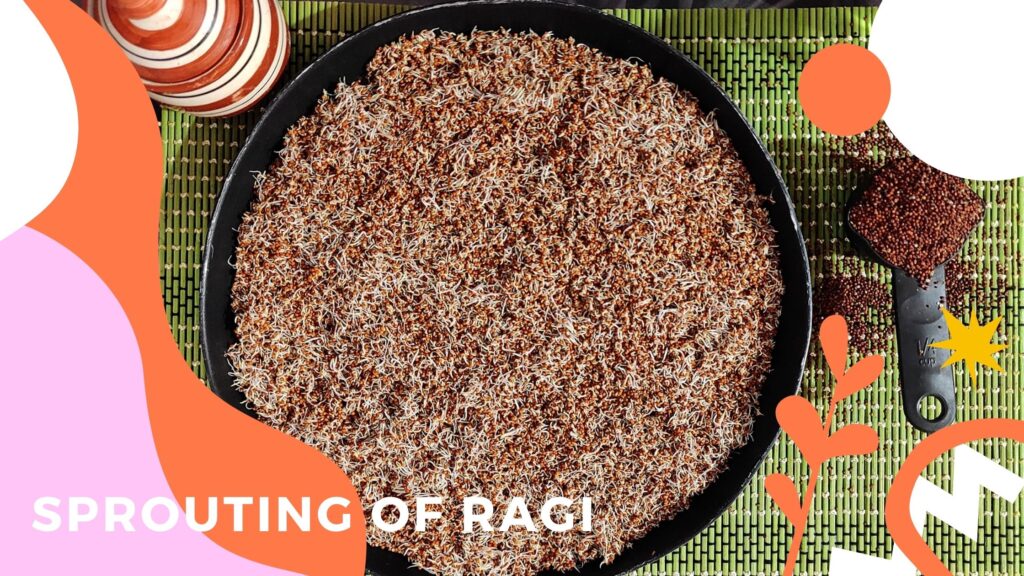
A study also showed that by soaking and germination of Finger Millet the bioavailability of Calcium increases in the body.
So, by following soaking and germination practices, nutritionally enriched millet products can be produced.
2. Pearl Millet Nutrition Facts:
| Nutrients | Content per 100 g |
| Iron | 6.42 mg |
| Zinc | 2.76 mg |
| Dietary Fiber | 11.4 g |
| Fat | 5.43 g |
Pearl Millet also contains a high proportion of proteins (12-16%) as well as lipids (4-6%). ICRISAT and Mahatma Phule Krishi Vidyapeeth jointly developed a high iron content variety of Pearl Millet under the biofortification program. The variety is named ‘’Dhanashakti’’ and was released in 2012 in Maharashtra.
Dhanashakti has the iron of 71 mg/kg and 40mg/kg of zinc.
ICRISAT has also developed another Pearl Millet variety (ICMH120) named Shakti1201. This variety contains 75mg/kg iron and 40 mg/kg Zinc. It is almost the same in the iron and zinc content as Dhanashakti but the performance of Shakti1201 is 30% higher.
3. Sorghum Nutrition Facts:
According to the report of the National Institute for Nutrition, Hyderabad every 100 grams of Sorghum grains contains nutrients as per the table below:
| Nutrients | Content per 100 gm |
| Carbohydrates | 67.7 g |
| Protein | 9.9 g |
| Fats | 1.73 g |
| Dietary Fiber | 10.2 g |
| Magnesium | 133 mg |
| Folic acid | 39.4 μg |
| Calcium | 27.6 mg |
| Phosphorous | 274 mg |
| Zinc | 1.9 mg |
| Thiamine | 0.35 mg |
| Riboflavin | 0.14 mg |
| Niacin | 2.1 mg |
Sorghum is known to be rich in phenolic compounds that act as antioxidants.
4. Little Millet Nutrition Facts:
Little millet is an excellent source of protein (10.13 g), dietary fiber (7.72 g), carbohydrates (65.55 g), iron(1.26 mg), phosphorus (130 mg/g), and magnesium (91.41 mg) per 100 g.
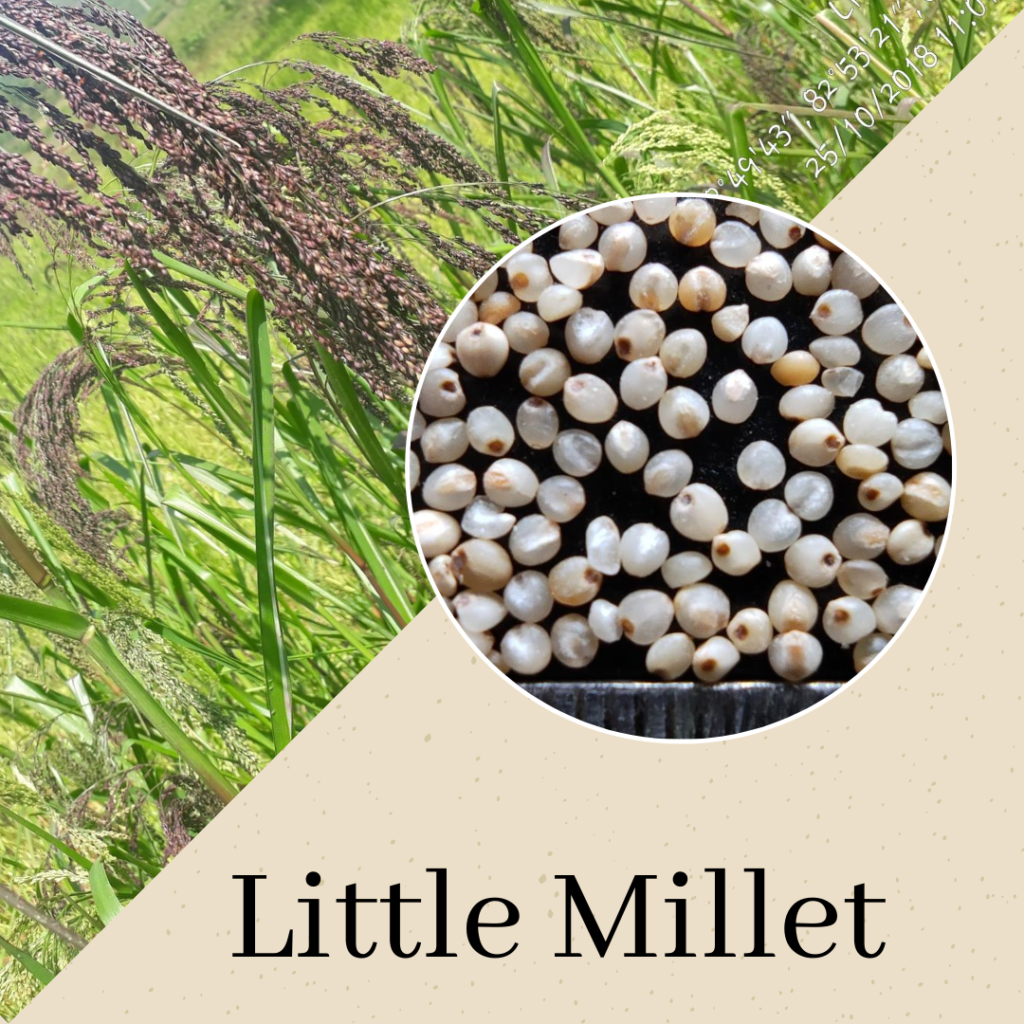
Little Millet also contains amino acids in balanced proportions. It is rich in methionine, lysine, and cysteine.
As Little millet is rich in methionine and cysteine and these amino acids are deficient in pulses, a judicious combination of Little millet and pulses would provide high-quality protein.
5. Foxtail Millet Nutrition Facts:
Foxtail Millet is rich in protein (12.3 g), crude fiber (8g), fat (4.3 g), Carbohydrates (60.9 g), and micronutrients like iron (2.8 g), zinc (2.4 g), magnesium (81 mg) and potassium (250 mg) per 100 g.
It also contains amylose (17.5%), amylopectin (82.5%), calcium (31 mg), and phosphorus (290 mg). Foxtail Millet contains balanced amino acids like arginine, histidine, lysine, tryptophan, phenylalanine, tyrosine, methionine, cystine, leucine, isoleucine, and valine.
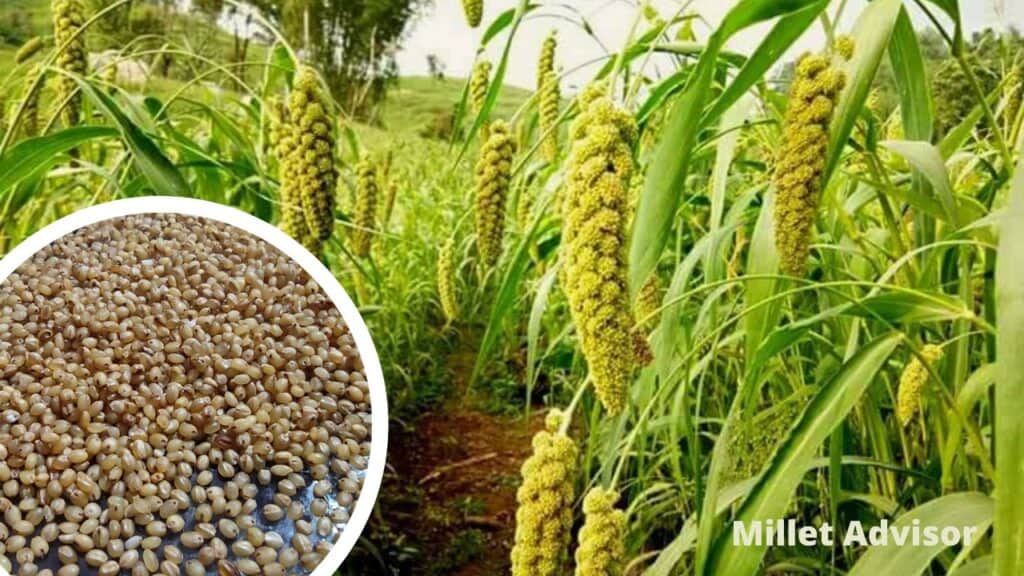
Foxtail millet also contains a good profile of vitamins like thiamine (0.59 mg), niacin (3.2 mg), riboflavin (0.11 mg), folic acid (15 mg), Vitamin A (32 mg), Vitamin B5(0.82 mg) and Vitamin E (31 mg).
6. Barnyard Millet Nutrition Facts:
Barnyard millet is a tremendous source of protein, dietary fiber, calcium, phosphorus, magnesium, zinc, iron, thiamine, riboflavin, niacin, and folic acid. The presence of phytochemicals and phenolic compounds enriches its antioxidant activity and makes it a superior grain.
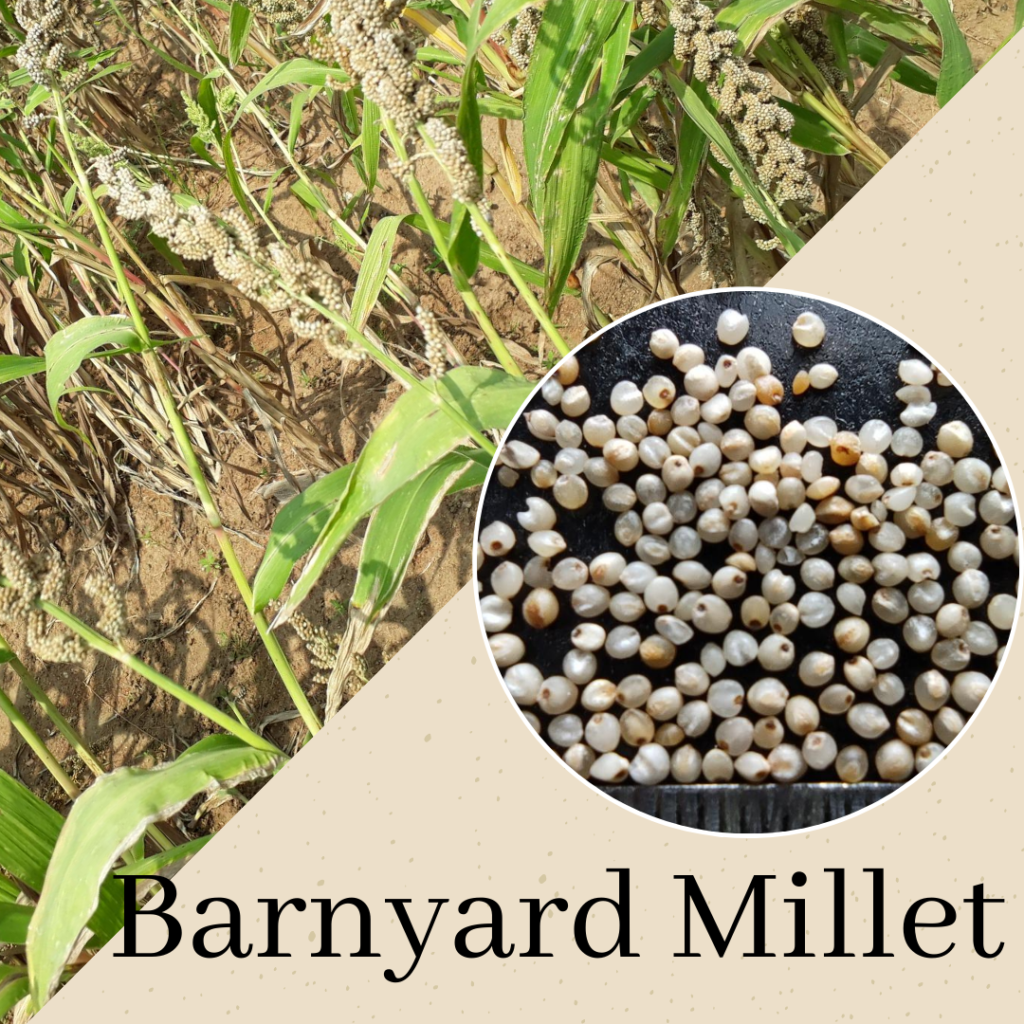
When Barnyard Millet is compared by taking polished and unpolished grains the nutritional value changes. This shows that the whole grain or the unpolished barnyard millet offers a better range of nutrients and phytochemicals than polished grains.
Quantitative Analysis of Nutrients present in Barnyard Millet (100 g)
| Sl.No. | Nutrients | Polished (mean) | Unpolished(mean) |
| 1 | Carbohydrates (gm) | 65.79 ± 0.02 | 68.8 ± 0.11 |
| 2 | Protein (gm) | 6.8 ± 0.08 | 10.4 ± 0.02 |
| 3 | Dietary fiber (gm) | 8.5 ± 1.3 | 14.2 ± 0.28 |
| 4 | Crude Fiber (gm) | 4.5 ± 0.35 | 11.2 ± 0.08 |
| 5 | Calcium (mg) | 24.8 ± 0.38 | 35 ± 0.10 |
| 6 | Iron (mg) | 6.2 ± 0.02 | 7.1 ± 0.11 |
| 7 | Thiamine (mg) | 0.37 ± 0.01 | 0.45 ± 0.04 |
| 8 | Niacin (mg) | 4.05 ± 0.02 | 4.08 ± 0.01 |
| 9 | Biotin (μg) | 20 ± 0.20 | 22 ± 0.16 |
| 10 | Folate (μg) | 69 ± 0.30 | 78 ± 0.01 |
7. Kodo Millet Nutrition Facts:
Kodo Millet is rich in vitamins, minerals, and phytochemicals. It is also rich in essential amino acids like lysine, threonine, valine, and sulfur-containing amino acids and the ratio of leucine to isoleucine is about 2.0 (Ravindram, 1992, Antony et al, 1996). Kodo Millet is rich in vitamin B3, Vitamin B6 as well as minerals such as calcium (15.27 g), magnesium (122 mg), phosphorus (101 mg), and zinc (1.65 mg) per 100g.
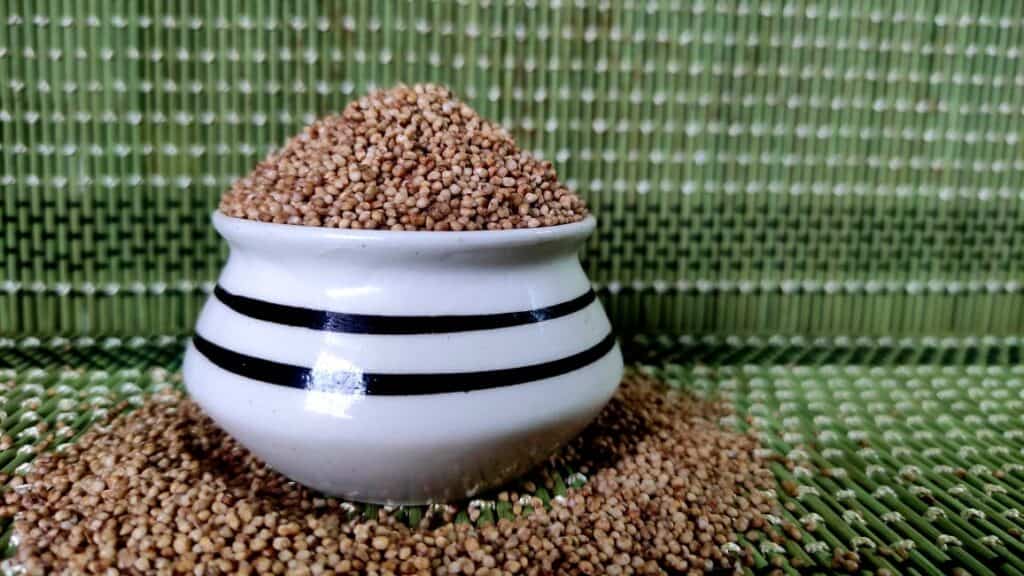
It contains dietary fiber of 6.39 g and provides 331 KCal energy per 100 gm of grain. According to the study of NIN, Hyderabad, Kodo Millet contains the highest amount of folic acid (39.99 mg) among all the millets.
8. Proso Millet Nutrition Facts:
Proso Millet is far ahead in terms of a few nutrients among millets. It has the highest protein (12.5 g), magnesium (153 mg), riboflavin (0.28 mg), and niacin (4.5 mg) per 100 gm of grains (Source: Indian Food Composition Table 2017 – National Institute of Nutrition).
9. Browntop Millet Nutrition Facts:
Compared with rice and wheat, Browntop Millet has high nutritional value. It is rich in fiber, iron, calcium, potassium, magnesium, and many other important minerals. Browntop millet contains rich protein (11.5 g), an excellent amount of fiber (12.5 g), minerals (4.2 g), iron (0.65 mg), and calcium (0.01 mg) per 100 gm of grain.
The takeaway from this section on the Millet Nutrition Facts:
Every millet is unique in its nutrient content. Focusing on the rich content of the particular millet and building a product will attract more consumers and an association will develop gradually. Here are the nutritive values of millets:
| Sl. No. | Nutrient | Millet | Nutritive value per 100 g. |
| 1 | Protein | Proso Millet | 12.5 g |
| Foxtail Millet | 12.3 g | ||
| 2 | Iron | Pearl Millet | 6.42 mg |
| Barnyard Millet | 5 mg | ||
| 3 | Zinc | Barnyard Millet | 3 mg |
| 4 | Magnesium | Proso Millet | 153 mg |
| 5 | Calcium | Finger Millet | 364 mg |
| 6 | Fat | Pearl Millet | 5.43 g |
| 7 | Dietary Fiber | Pearl Millet | 11.4 g |
| 8 | Folic acid | Kodo Millet | 39.4 μg |
| Sorghum | 39.42 | ||
| 9 | Phosphorous | Foxtail Millet | 290 mg |
| 10 | Carbohydrates | Foxtail Millet | 60.2 g |
Conclusion:
Hope this article has given you a deep knowledge on the millet nutrition facts. However, we should be careful on the extent of millet processing. Over processing deteriotes the nutrition content of the millets. So, always be careful in choosing the right kind of millets and try to avoid the polished millets. Further, there is a need of more Reasearch and Development in Millet Nutrition, specifically of the millet landraces varieties which are still unexplored.
Author: Tapas Chandra Roy, A Certified Farm Advisor on Millets, ‘Promoting Millets from Farm to Plate’ and an Author of the book -” Millet Business Ideas-Empowering Millet Startups”. In a mission to take the forgotten grains- Millets to Millions. To remain updated on my blogs on Millets please subscribe to my newsletter and for any queries please feel free to write to [email protected]


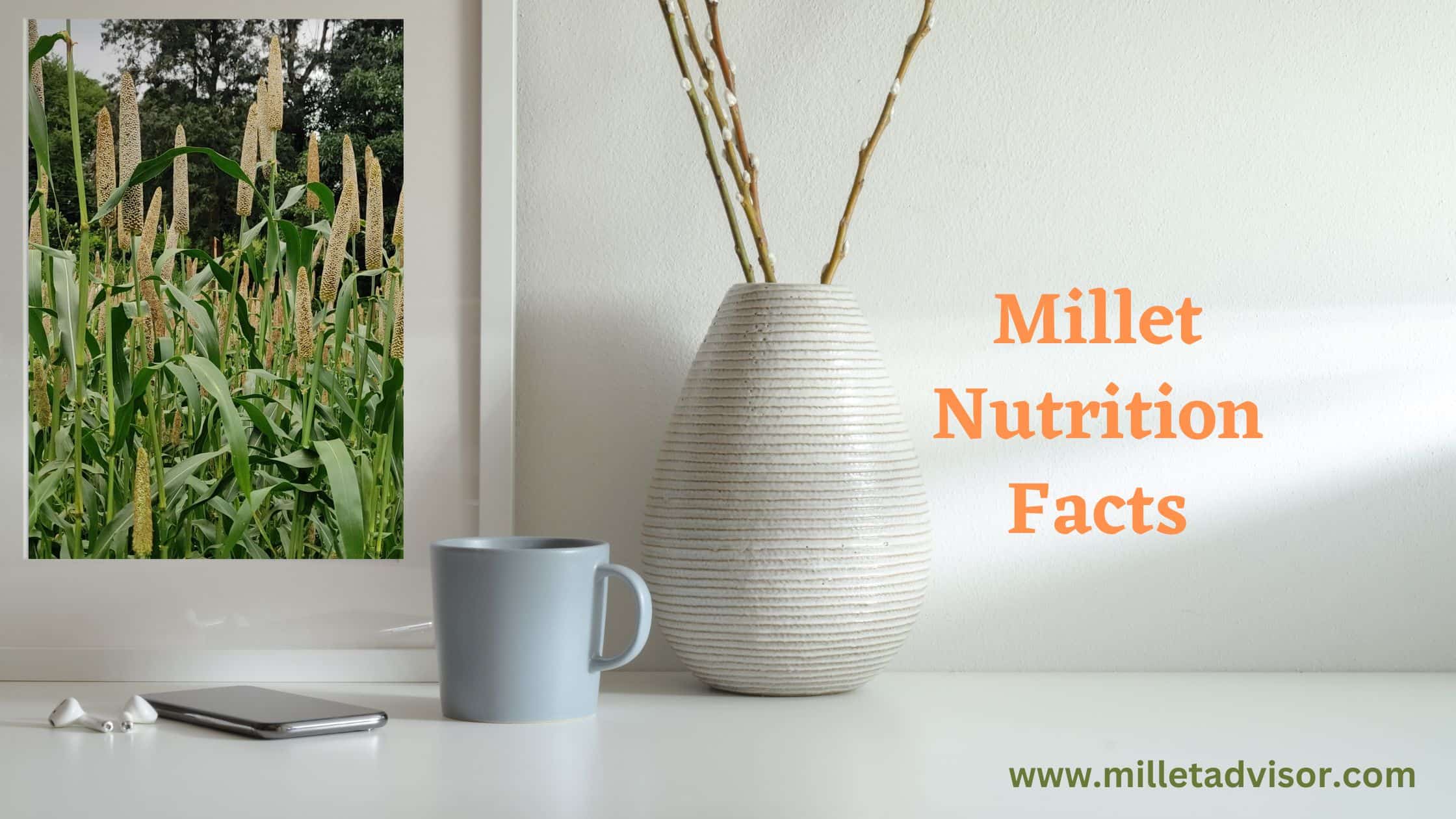
Thank you for sharing an informative article on millets. We are working on developing sports supplements from millets especially underutilised millets and pseudo millets. We are interested in information on amino acid profile of the millets if available.
We have done extensive research on germination of millets and it’s nutritive value as well as utilisation for young child feeding.
Thank you for sharing valuable information. More useful for bring awareness among rural women.